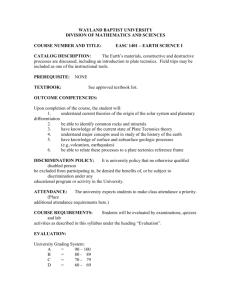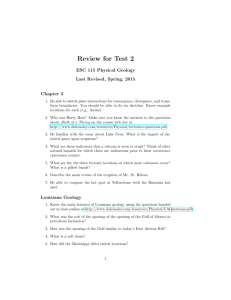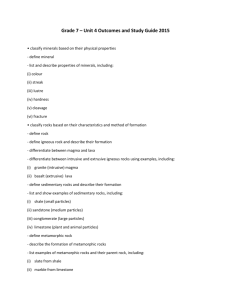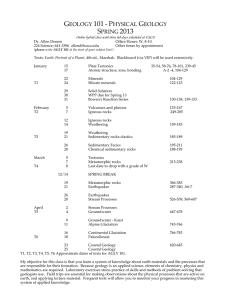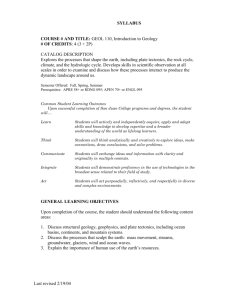Geology 1301 Exam Study Outlines
advertisement
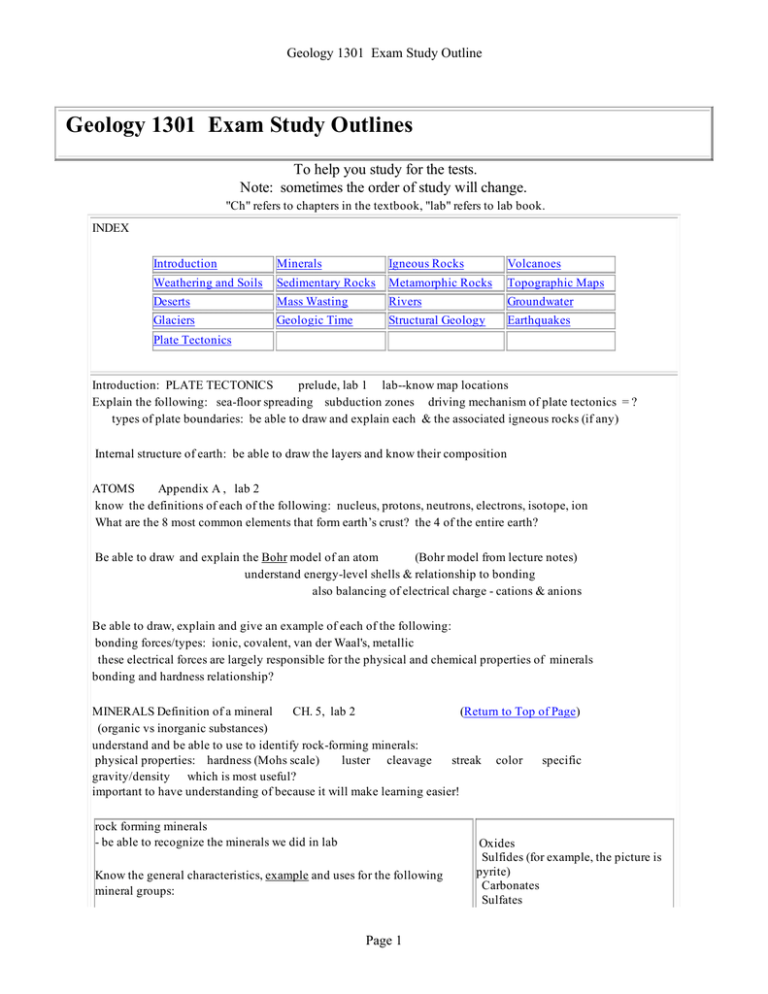
Geology 1301 Exam Study Outline Geology 1301 Exam Study Outlines To help you study for the tests. Note: sometimes the order of study will change. "Ch" refers to chapters in the textbook, "lab" refers to lab book. INDEX Introduction Minerals Igneous Rocks Volcanoes Weathering and Soils Sedimentary Rocks Metamorphic Rocks Topographic Maps Deserts Mass Wasting Rivers Groundwater Glaciers Geologic Time Structural Geology Earthquakes Plate Tectonics Introduction: PLATE TECTONICS prelude, lab 1 lab--know map locations Explain the following: sea-floor spreading subduction zones driving mechanism of plate tectonics = ? types of plate boundaries: be able to draw and explain each & the associated igneous rocks (if any) Internal structure of earth: be able to draw the layers and know their composition ATOMS Appendix A , lab 2 know the definitions of each of the following: nucleus, protons, neutrons, electrons, isotope, ion What are the 8 most common elements that form earth’s crust? the 4 of the entire earth? Be able to draw and explain the Bohr model of an atom (Bohr model from lecture notes) understand energy-level shells & relationship to bonding also balancing of electrical charge - cations & anions Be able to draw, explain and give an example of each of the following: bonding forces/types: ionic, covalent, van der Waal's, metallic these electrical forces are largely responsible for the physical and chemical properties of minerals bonding and hardness relationship? MINERALS Definition of a mineral CH. 5, lab 2 (Return to Top of Page) (organic vs inorganic substances) understand and be able to use to identify rock-forming minerals: physical properties: hardness (Mohs scale) luster cleavage streak color specific gravity/density which is most useful? important to have understanding of because it will make learning easier! rock forming minerals - be able to recognize the minerals we did in lab Know the general characteristics, example and uses for the following mineral groups: Page 1 Oxides Sulfides (for example, the picture is pyrite) Carbonates Sulfates Geology 1301 Exam Study Outline Silicates ferromagnesians & nonferromagnesians silica tetrahedra & molecular structure Halides Mineraloids Native Element (chains, sheets, etc) Polymorphs: what are they? give an example IGNEOUS ROCKS Ch A, 6, lab 3 (Return to Top of Page) Extrusive vs intrusive magma vs lava - pahoehoe and aa ***BOWEN’S REACTION SERIES*** amount of silica determines what? Be able to DRAW, know description, type of eruption & characteristics of: all the volcanic and plutonic landforms discussed/shown Magma Explain movement of: lighter & stoping Composition of: silica etc **Behavior of & relationship to composition, temperature, pressure Viscosity Igneous rock textures: what are they? what do they tell us about rock formation? (Return to Top of Page) What is a xenolith? Igneous magma compositions: silicic(felsic) vs intermediate vs mafic --refer to Bowen's Series **rock names & definitions from classification chart** Be able to recognize each of the following and know their relationship to Bowen’s series (if any) granite & rhyolite diorite & andesite gabbro & basalt --- difference depends on? peridotite obsidian scoria pumice **Relationship of igneous rocks to plate tectonics** **generation of basaltic & silicic magmas including magmatic differentiation by partial melting and by mineral fractionization SEDIMENTATION AND SEDIMENTARY ROCKS Ch 7, lab 4 (Return to Top of Page) Sedimentary cycle be able to draw it Clastic/Detrital Sedimentary Rocks Terrigenous means? To describe rock texture: clast/grain size, relation to transport? breccia, conglomerate - what’s the difference? what do they say about distance of transport? sandstone - relation of composition to transport distance? sorting by size, weight, durability, relation to transport? shape: round vs angular, relation to transport? *porosity & *permeability ---- what are they? difference? Composition: **mineral stability** and Bowen’s series **5 main factors that influence clastic composition** source rock weathering/climate transport - what are the different means of transport? deposition Diagenesis - which is? Page 2 environ of Geology 1301 Exam Study Outline Chemical Sediments named by composition limestone - made of? textures? (dolostone) evaporites Diagenesis of chemical rocks susceptibility? recrystallization chert coal SEDIMENTARY ROCKS AND PLATE TECTONICS CH. 7, lab 4 Which rock types are the most useful for deciphering plate tectonic environment? Why? NOT useful? Why? Which rock types are DEPOSITIONAL ENVIRONMENTS AND SEDIMENTARY FACIES ch. 7, lab 4 Deposition relation particle size & environment deposited in, other clues to depositional environment = ? Sedimentary structures -Primary: bedding = parallel/graded/cross beds mud cracks& raindrop impressions trace fossils imbrications geodes stylolites color Secondary concretions Facies = ? Varies over time & space Sedimentary environments - distinguishing characteristics? ex., dominant grain size? Terrestrial Transitional Fluvial, Lacustrine, swamp-marsh, eolian, glacial, landslides beach, lagoon, estuary Marine shelf, slope, rise, abyssal plain submarine fan (turbidites) marine evaporite basin (Return to Top of METAMORPHISM AND METAMORPHIC ROCKS CH. 8 & B, lab 5 Page) CONTROLLING FACTORS Heat/temperature: source of heat? Pressure: source and type of pressure types of foliation produced Chemical activity: especially water vapor Other Factors: Composition of original rock Time In general: high T, high P, long time ----- large crystals, high grade low T, low P, short time ----- small crystals, low grade TYPES OF METAMORPHIC ROCKS TYPES OF METAMORPHISM ? Metamorphic facies: definition of and what do they tell us? examples? ***PLATE TECTONICS AND METAMORPHISM*** Understand variations in pressure, temp in a subduction zone - be able to draw subduction zone & show where different rock types form TOPOGRAPHIC MAPS Ch. E, (Appendix D), labs 8 and 9 (Return to Top of Page) What are they used for? What do they tell you? What types of scales are used? Why are there different scales? Page 3 Geology 1301 Exam Study Outline What is latitude? longitude? Given a topographic map - be able to tell the following: type of landscape shown: rugged, flat, etc where are the lakes, rivers, swamps, cliffs, gentle slopes.... rough distance between two points; calculate contour interval GEOLOGIC TIME Ch12 Sedimentary Rocks = core of historical geology provide information on depositional environment, climate and tectonic history Some basic rules to help figure out what happened when = RELATIVE AGES - Most sediments & volcanics are deposited horizontally (parallel to surface) - oldest rock on the bottom, youngest rock on the top - cross-cutting relationships: igneous intrusions, faults, unconformities UNCONFORMITIES = ? ABSOLUTE TIME three types of = ? be able to recognize and draw the three types. Radiometric decay: theory, rate, example, general technique THE SOLAR SYSTEM (Return to Index) *The origin of the solar system/solar nebula theory - why are the inner planets different from the outer ones? Meteorites & Asteroids & Craters Terrestrial Planets: general characteristics of: Mercury, Venus, Earth & Moon, Mars Jovian Planets general characteristics of: Jupiter, Saturn, Uranus, Neptune, Pluto & of the larger moons Which planets (moons) have active plate tectonics? life? THE ARCHEAN Ch13 Rocks -granulites (granite-gneiss) & greenstone belts each active volcanos? magnetic fields? liquid water? (Return to Index) -- sedimentary & volcanic rocks *environment of formation for banded iron formation rare nonmarine & continental shelf deposits why rare? Tectonics -- what were the continents like in the Archean? what kind of volcanic activity was around? Life -- evidence for? type of organisms? - hypotheses to explain stages by which life could have formed from nonliving matter PROTEROZOIC (Return to Index) much more like Phanerozoic, LARGE CRATONS APPEAR where first? what does it say about tectonics in the Ptz? what's the evidence? Page 4 Geology 1301 Exam Study Outline Atmospheric Oxygen primitive atm composition evidence atm evolved from anaerobic to aerobic relationship of oxy level to U & Fe minerals, red beds, BIF, bacteria, eukaryotic cells controls on concentration of oxy in atm: photosynthesis ozone shield stromatolites volcanos Life Eukaryote vs prokaryote differences between them Acritarchs Proterozoic of Franklin Mountains THE WORLDWIDE GLACIATIONS further evidence had rigid, continental crust Early Proterozoic Glaciation extent, features, age Late Proterozoic Glaciation extent, features, age, problems evidence from stromatolites & paleomagnetism theories LIFE IN THE PROTEROZOIC 1st MULTICELLULAR: was? flound where? and when? MULTICELLULAR ANIMALS first appearance was? - Ediacara fauna - animals (phyla) found? - older examples? - early trace fossils & the late Ptz glaciation EARLY PALEOZOIC WORLD to Index) Ch13 (Return Causes of sea level rise and fall? evidence for sea level rise and fall? Early Paleozoic rocks of the El Paso area? Ordovician mass extinction - one of most severe cause? Evidence for? Early Paleozoic tectonic activity/orogenic events - where? tectonic causes? EARLY PALEOZOIC LIFE Next big step in development of life =? why appear now? what for? Small Shelly Fauna characteristics, animals found Burgess Shale, middle Cambrian depositional environment of Burgess? preservation of fossils? animals present? why so many soft-bodied creatures preserved? - Important Cambrian organisms? which Cambrian organisms built reefs? which organisms had eyes? largest predator of Cambrian seas? Trilobites were? protection techniques? index fossils for ? lifestyle Page 5 were the reefs large or small? Geology 1301 Exam Study Outline Ordovician Adaptive Radiation which organisms important in Ordovician? the Ordovician carnivores were? what were the first fish like? the Ordovician reef builders were? Did plants invade the land during the early Paleozoic? what were they like? MIDDLE PALEOZOIC WORLD Index) Baltica & Laurentia suture together - mtns where? create which supercontinent? Tectonics in North America - east side? & west side? evidence for? and in El Paso? Sea Level High or Low? (Return to Late Devonian mass extinction organisms affected? probable cause? evidence of cause? Recovery of old organisms & new organisms present Reefs - built by what? new swimming animals =? on land: problems organisms had to solve to live on land? plants - types, characteristics of characteristics of LATE PALEOZOIC WORLD Index) marked by major climate changes - evidence? Tectonics - formation of Pangea - mtns where?, incl. deformation away from margins North America = activity where? due to what? affects of? LIFE - Oceans reefs or bioherms? important organisms of animals - types, (Return to changes in fishes Which were the important land plants? What is their economic importance today? freshwater animals insects, amphibians & *reptiles (amniotic egg: characteristics, adv.) later reptiles develop what important feature? therapsids & endothermy carnivores = ? mass extinction @ Perm/Tr - affected what? what survived? top cause? EARLY MESOZOIC (Return to Index) Tectonics & climate - Life substantially different from that of Pz Pangea breaks up - evidence for? how? why? conditions on Pangea - sediments mass extinctions @ end Triassic conditions in NAm - west vs east coasts hurt which organisms? benefited which? theory of? evidence for? what were the dominant/important organisms of the Early Mesozoic? in the Oceans? Land: both animals & plants distinctive - how? dominant plants? DINOSAURS Ornithiscians (bird-hipped) vs Saurischians (lizard-hipped) **Lifestyles of** types of? descendants of? Birds - Archaeopteryx - characteristics of, lifestyle of, evidence? Mammals, Turtles LATE MESOZOIC Tectonics & Climate (Return to Index) Sea level high, climate warm - evidence? Page 6 Geology 1301 Exam Study Outline Gondwana breaks up - new oceans, more evaporites, etc. North America - east coast vs Gulf coast vs west coast Life = mix of modern (examples?) & archaic (examples?) Oceans: Rise of modern predators probably had what effect on benthic life? type of predators? Land: Plants? More dinosaurs - same types as before? flying reptiles - what kind? & birds other vertebrates? MASS EXTINCTIONS - THE FIVE BIG ONES When? due to what? evidence? Cretaceous/Tertiary extinction - cause? evidence? alternative theories? EARLY CENOZOIC (Return to Index) Life - Appearance of what modern organisms? Marine Fish (which type?), reefs built by? microfossils = ? top predators = ? any new marine ecological niches exploited? Terrestrial Plants any drastic changes since Mesozoic? **major event = ? tied to what changes in animal life? Animals with dinosaurs gone, mammals do what? evolutionary history of horse Largest land mammal was ? predators = ? General trends in mammal evolution? Paleogeography Major continental rifting event? Effect on climate? North America West: accreted terranes East coast? LARAMIDE OROGENY reactivated what? associated rock types? results? What's happening here? evidence? Gulf Coast probable cause? Mediterranean Alps - cause? results? Himalayas: how formed? (Return to Index) LATE CENOZOIC time with major changes in life and in physical features of earth Life Aquatic most dramatic change = ? Land profoundly influenced by what? plant change? Vertebrates *small creatures Expansion of many mammals related to ? Large animals & carnivores Development of primates Late Neogene Climate Change Pleistocene Continental Glaciation primarily in which hemisphere? Causes extent? alternations of glacial/interglacial? (today's extent?) evidence of? effects of? furthest Paleogeography Neogene Western North America - Locate modern physiographic provinces in the western U.S. & relate them back to their plate tectonic cause for example: the Cascades = volcanic peaks from subduction of Farallon/Juan de Fuca plate Especially, the Basin & Range - *Possible mechanisms of uplift & igneous activity of Basin & Range relationship to Rio Grande Rift Volcanic activity in New Mexico Page 7 Geology 1301 Exam Study Outline Eastern North America events here? Caribbean Region major changes in late Neogene = ? Africa events here? DESERTS & WIND ACTION (Return to Index) ch. 21, lab 13 (Return to Top of Page) characteristics of ? DESERT CLIMATE: Origin of ? SURFACE PROCESSES & LANDFORMS IN DESERTS weathering & mass wasting Fans & Bajadas streams & lakes WIND AS A GEOLOGIC AGENT Erosion: deflation & abrasion Transport: bed (saltation) & Pediments desert pavement Deposition: Wind-blown sand: Sand Ripples Dunes: form, height, migration, sand seas factors affecting dune type Wind-blown dust: mobilization of transport of & dust storms loess Wind suspension load ventifacts ----be able to DRAW ADVANCING DESERTS & DESERTIFICATION: impact & countermeasures MASS-WASTING ch. 16, Lab 10 definition & role of water & gravity Other factors involved in stability? types of mass wasting? (Return to Top of Page) TRIGGERING OF MASS-WASTING EVENTS what are some triggers? Classification based on what fundamental differences/characteristics? which are just inconvenient? Slope Failures: slumps, rockfalls, rockslides Sediment Flows Slurry Flows: solifluction, debris flows (mudflows) avalanches Debris avalanches or long-run-out landslides which would be dangerous & why? Granular Flows: creep, earthflow (liquefaction), debris features of? explanations of? examples Subaqueous mass-movement & turbidites MASS-WASTING HAZARDS Assessment & Mitigation be able to analyze a given slope for risk & mitigation techniques local examples? DEBRIS-FLOW FILM Describe a Debris-flow: what do they look like? how are they different from streamflow? how fast do they go? can they move boulders? how big? if so, how are they moved? Page 8 Geology 1301 Exam Study Outline Water in El Paso RIVERS roles in human life & in geology = ? Ch. 17, Lab 11 Why is flow velocity important in understanding river behavior? (Return to Top of Page) What four factors affect velocity? Rivers erode - how? (3 ways) Rivers Transport - types of Load Why are some rivers muddy (have lots of load) & others not? How do people affect load? Rivers deposit why? what? DEPOSITIONAL FEATURES OF STREAMS Floodplains & levees Alluvial fans Terraces deltas Bars GROUNDWATER ch. 19, lab 12 AQUIFERS - conditions for? example? El Paso’s water supply = ? Our aquifer? (Return to Top of Page) THE GROUNDWATER SYSTEM Recharge area = ? arid versus humid climates (be able to draw & explain arid) discharge area = ? GEOLOGIC ACTIVITY OF GROUNDWATER Dissolution & Transport --- Chemical content of groundwater Chemical cementation & replacement CONTAMINATION OF GROUNDWATER SUPPLIES Sources of? types? GLACIERS AND GLACIAL ROCKS ch. 22 lab 14 Treatment of? (Return to Top of Page) Glacier = ? and glacial ice (difference between snow & glacial ice) types of? how can you tell them apart? what landforms does each type create? Changes in glacier mass: zones of accumulation & ablation, snowline Movement of glaciers = ? crevasses velocity & direction of flow glacier surges Glacial erosion: such as? Glacial Transport - how different from wind or water transport? Glacial Deposits examples? what do they tell geologists? THE GLACIAL AGES Pleistocene -how do we know it happened? where was the ice (generally)? how can we tell? what effects did the Ice Age have on animal/people distribution? on the sea level? also in Late Paleozoic in the southern continents: how do we know? Causes of: plate tectonics - how cause glaciations? (3 ways) minor variations in orbit & inclination/tilt of earth’s axis volcanic activity weathering Effects of global warming on earth. Oceanography Page 9 Geology 1301 Exam Study Outline What are the main causes of motion in the ocean? Explain each. What ions are from eroded rocks? What from volcanic eruptions? How did BIFs form? How could global warming affect gyres? What are the major ocean depositional environments? What rocks & sedimentary structures are formed in each? Why is the ocean floor made of basalt? How can people protect the shore? Know fetch, longshore current, gyre, spit, rip current DEFORMATION OF ROCK & ROCK STRUCTURE ch.11, lab 15 (Return to Top of Page) Movement --- stress (force) --- strain (deformation) 3 types of stress & strain produced are? Elastic vs Plastic strain & strength of rock If rock strength exceeded: Fails --- either Ductile (plastic flow) or Brittle (ruptures) Type of rock deformation depends on? Brittle failure how recognize faults? types of faults: Be able to draw type of stress for each? effects on crust? & graben what are: compound faults: ex., horst can a strike-slip fault also have vertical motion? slickensides and drag folds - useful for what? DEFORMATION BY BENDING: ductile deformation types of folds? how tell them apart? be able to draw them is there a recumbent fold near you? EARTHQUAKES ch. 10, lab 16 (Return to Top of Page) Occurrence & Risk of & Disasters Risk in El Paso? in the U.S.? ORIGIN OF EARTHQUAKES? earthquake focus & epicenter - definitions of SEISMIC WAVES: BODY WAVES & SURFACE WAVES - types of? characteristics of each? MAGNITUDES OF EARTHQUAKES Richter Scale: how calculated? EARTHQUAKE DAMAGE Primary: types of? Secondary: types of? Modified Mercalli Scale: # of earthquakes/year & relation to strength EARTHQUAKE INTENSITY: varies with what? which is the worst ground type to build on? fundamental frequency = resonance - what happens if fundamental frequencies of ground & matches? MITIGATION OF HAZARD PREDICTION - what do we know? what don’t we know? PREPARATION of individual: how can you prepare for an earthquake? EXPLORATION SEISMOLOGY principal use? what is the basic technique? REFLECTED VS REFRACTED WAVE PATHS Page 10 buildings Geology 1301 Exam Study Outline THE EARTH’S INTERNAL STRUCTURE ch. 10 BEHAVIOR OF SEISMIC WAVES define 3 very pronounced boundaries in the earth, separating 4 fundamentally different zones - which are? THE CRUST: thickness & composition of **oceanic vs continental crust** THE MANTLE: composition of? The Low-velocity Layer = the asthenosphere how know its there? what’s the explanation of it? **relationship to plate tectonics** depth of & relationship to crust thickness? The 400 km Seismic Discontinuity: how know it’s there? what’s the explanation of it? The 670 km Seismic Discontinuity: how know it’s there? what’s the explanation of it? relationship to occurrence of earthquakes? THE CORE: density & composition of difference between outer & inner core? evidence from seismic & meteorites? WORLD DISTRIBUTION OF EARTHQUAKES **relation to plate tectonics** Seismic Belts: Circum-Pacific Depth of Quakes: shallow-focus, intermediate & deep-focus Benioff Zone & the descending slab GRAVITY ANOMALIES measuring gravity differences tells you what? ISOSTACY due to what? and mountain roots and crust thickness: continental vs. oceanic crust PLATE TECTONICS ch. 3 & 4, lab 17 Wegener & Continental Drift & Pangea Apparent Polar Wander Hess & Seafloor Spreading (Return to Top of Page) Structure of a Plate Be able to draw each of the boundary types and know the rocks that form at each boundary Divergent Margins: magnetic records & plate velocities Convergent Margins: Island arcs, mélange/subduction complex Transform Fault Margins Plate Tectonics and Continental Crust Continental Margins: active vs. passive Hot Spots & Absolute plate velocity CAUSES OF PLATE TECTONICS Lithosphere Convection in the Mantle Back to INDEX Copyright 2003-2015 ©Kathleen Devaney Page 11 Movement of the
